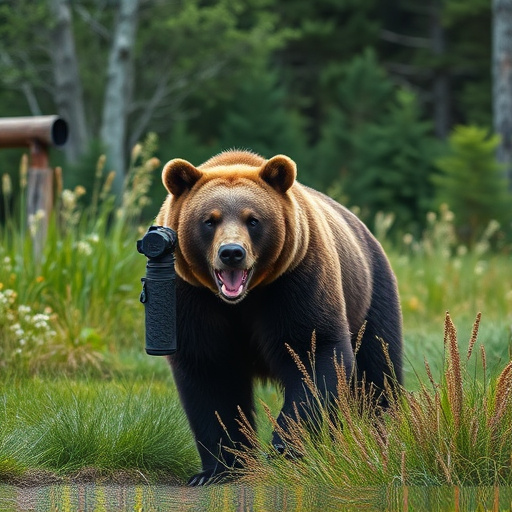Bear spray is a vital safety tool for outdoor enthusiasts in bear country, with two main types: oleoresin capsaicin (OC) and synthetic capsaicin. Understanding local Bear Spray Legal Requirements by State is crucial as regulations vary across the US. Before using, familiarize yourself with permitted types, brands, strengths, and sizes; practice application techniques; and follow best practices for storage and use to ensure safety and compliance.
Backpacking through wilderness areas presents an exciting yet potentially dangerous encounter with bears. Enter bear spray—a crucial safety gear that can deter and defend against aggressive encounters. This comprehensive guide explores bear spray’s benefits, different types, and legal considerations across states. You’ll learn about application techniques, safe handling practices, and essential tips for backpacking trips. Understanding bear spray legal requirements by state ensures you’re prepared, informed, and in compliance.
- Understanding Bear Spray: Benefits and Types
- Bear Spray Legalities: A State-by-State Guide
- Choosing the Right Gear: Application and Safety Tips
- Best Practices for Carrying and Using Bear Spray During Backpacking Trips
Understanding Bear Spray: Benefits and Types
Bear spray, also known as bear repellent, is a valuable safety tool for anyone venturing into bear country. It’s a versatile defense mechanism that can be used to deter aggressive bears and provide a crucial extra layer of protection during outdoor activities like hiking, camping, or hunting. Understanding its mechanics and types is essential for effective deployment and knowledge of local legal requirements, such as Bear Spray Legal Requirements by State, ensuring safe interactions with these majestic yet potentially dangerous animals.
There are primarily two types of bear spray: oleoresin capsaicin (OC) and synthetic capsaicin. OC spray is derived from chili peppers and is known for its high concentration of active ingredients, offering broad-spectrum protection against both black and grizzly bears. Synthetic capsaicin sprays, on the other hand, are more environmentally friendly, as they degrade faster but still provide effective bear deterrence. Each state in the US may have specific regulations regarding the type, volume, and storage of bear spray, so being informed about local Bear Spray Legal Requirements by State is vital for responsible usage.
Bear Spray Legalities: A State-by-State Guide
Bear spray, a potent pepper spray designed for self-defense against bears, is an essential safety gear for anyone venturing into bear country. However, its legality varies across states in the US, making it crucial for outdoor enthusiasts to understand the Bear Spray Legal Requirements by State before embarking on their adventures. Some states mandate carrying bear spray while others simply recommend it, with varying restrictions on types allowed and storage.
For instance, Alaska, known for its bustling wilderness, requires all hikers and campers to carry bear spray, while California permits its use but doesn’t make it mandatory in most areas. States like Colorado and Washington have specific guidelines dictating the minimum OC (oleoresin capsicum) concentration and container size. Always check local regulations before heading out; these laws can change, ensuring you stay compliant with the latest Bear Spray Legal Requirements by State.
Choosing the Right Gear: Application and Safety Tips
When it comes to choosing the right backpacking bear spray safety gear, understanding local legal requirements is crucial. Each state in the US has its own rules regarding the possession and use of bear spray, so knowing what’s permitted is essential for responsible outdoor travel. Some states require specific types or brands, while others have restrictions on carrying certain strengths or sizes. Researching these Bear Spray Legal Requirements by State before your trip can save you from legal troubles and ensure you have a safe and enjoyable adventure.
Proper application techniques are just as important as having the right gear. Bear spray should be used as a last resort when facing an aggressive bear encounter. Aim for the face and eyes, using quick, short bursts to create a barrier between you and the bear. Remember, it’s better to prevent encounters through noise making, food storage, and awareness than to rely solely on bear spray. Always practice with your spray before venturing into bear country to ensure its effectiveness and familiarize yourself with any safety precautions specific to your chosen destination.
Best Practices for Carrying and Using Bear Spray During Backpacking Trips
When packing bear spray for backpacking trips, it’s crucial to follow best practices to ensure safety and compliance with local regulations. First, familiarize yourself with Bear Spray Legal Requirements by State, as rules vary widely. Always store bear spray in its original packaging, keeping it easily accessible yet secure in your backpack. During hikes, remain calm if you encounter a bear; use the “stop, back away, raise spray” method to assess the situation.
Before spraying, give bears plenty of space and time to retreat; only use bear spray as a last resort. When applying spray, aim for the bear’s face and eyes from a safe distance (20-30 feet). After a confrontation, clean and store your spray properly, as residual chemicals can attract wildlife. Remember that no method is foolproof; stay alert, make noise while hiking, and carry other deterrents like bells or whistles to reduce bear encounter risks.
Backpacking through wild landscapes comes with unique risks, and bear spray is a valuable tool for adventurers navigating areas with bear populations. Understanding the legal requirements for carrying bear spray varies state-by-state, as our guide highlights. When choosing the right gear, it’s crucial to select a high-quality product suitable for your needs. Proper application and safety tips can make all the difference in an encounter. Always follow best practices for carrying and using bear spray to ensure a safe and enjoyable backpacking experience. Stay informed about local regulations, be prepared, and respect wildlife for a memorable adventure.
